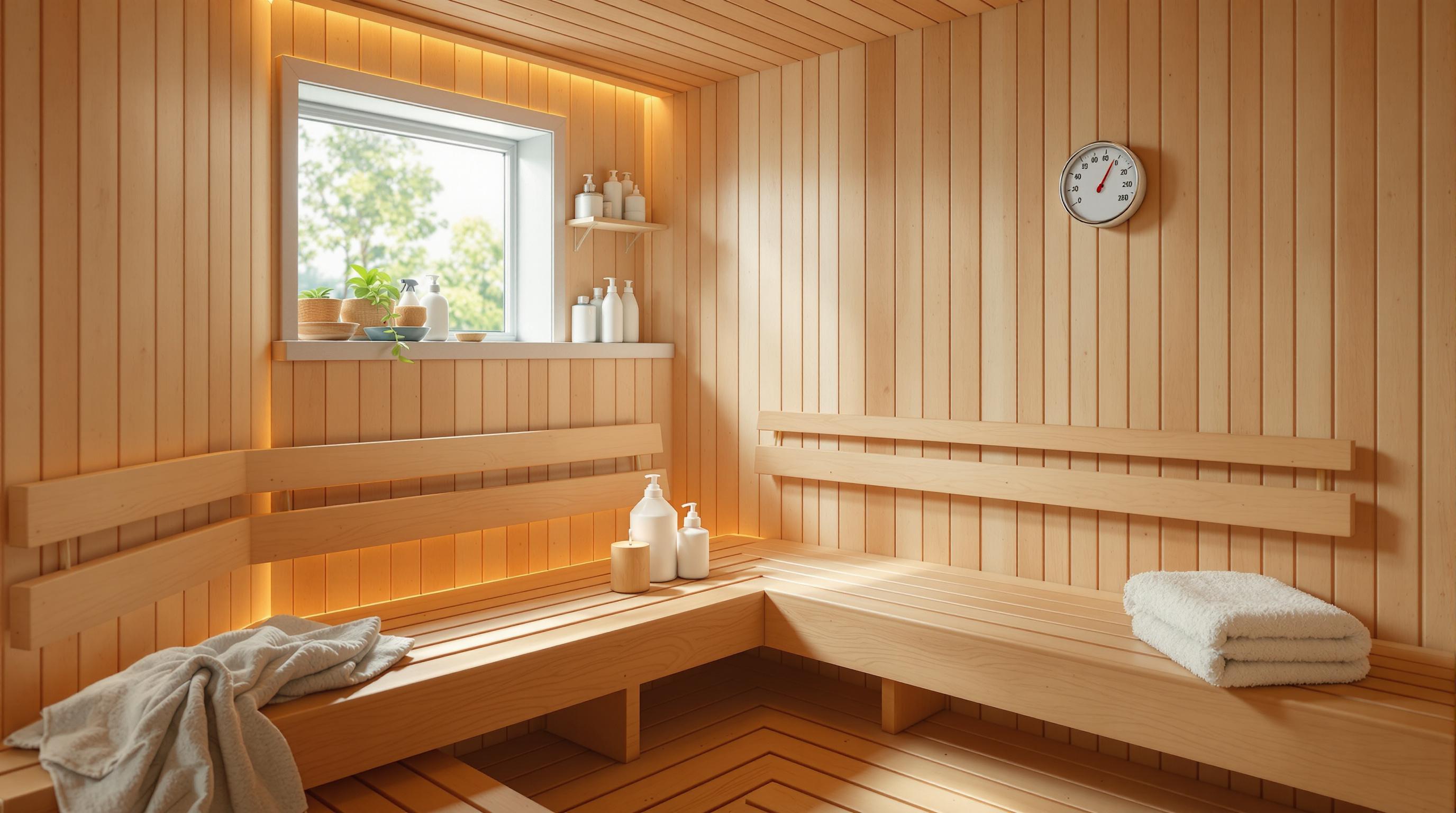Trying to decide between a steam sauna and an infrared sauna? Here's a quick breakdown to help you choose:
- Steam Saunas: Offer hot, humid air (110°F–130°F) that’s great for breathing and skin health. They deliver a classic sauna experience but require more setup (plumbing, waterproofing) and maintenance. Weekly running cost: $21.
- Infrared Saunas: Use dry heat (100°F–140°F) that penetrates deep into your tissues, ideal for muscle relief and longer sessions. Easier to install (plug-and-play) and maintain, with a lower weekly cost: $5.
Quick Comparison:
| Feature | Steam Sauna | Infrared Sauna |
|---|---|---|
| Heat Type | Humid heat | Dry, penetrating warmth |
| Setup | Complex (needs plumbing) | Simple (plug-and-play) |
| Running Cost | $21/week | $5/week |
| Best For | Breathing, skin health | Muscle relief, longer use |
Bottom Line: Choose a steam sauna for a traditional, humid experience or an infrared sauna for low-maintenance, targeted heat therapy. Think about your health goals, space, and budget to find your perfect match.
Related video from YouTube
Comparing Steam and Infrared Saunas
Let's break down the key differences between steam and infrared saunas to help you pick the right one for your needs.
| Feature | Steam Sauna | Infrared Sauna |
|---|---|---|
| Heat-up Time | 45 minutes | 15-20 minutes |
| Weekly Running Cost | $21 | $5 |
| Installation | Complex (requires plumbing) | Simple (plug-and-play) |
| Environment | Wet, humid heat | Dry, penetrating warmth |
Steam saunas bring the classic sauna experience right to your home. They work by using heated stones or a steam generator to create a hot, humid space - perfect if you love that traditional steamy feel. On the flip side, infrared saunas use special heaters that send heat directly into your body in a dry setting. This makes them a great choice if you're not a fan of humidity or have breathing issues.
The experience in each type feels quite different. In a steam sauna, you'll sit in temperatures of 110°F to 130°F with humidity levels of 40-60% - think tropical paradise levels of moisture. Infrared saunas run at similar temps (100°F-140°F) but keep things dry, making them much more bearable if you're not into that steamy jungle vibe.
Time matters too. Steam saunas need you to stick around longer since your body takes time to adjust to all that humidity. With infrared, you can pop in for a quick session and get the same benefits, as the heat goes straight to where it needs to be.
Here's the kicker: infrared saunas heat up in just 15-20 minutes (compared to 45 for steam) and cost way less to run - we're talking $5 versus $21 per week. Plus, you won't need to call a plumber for installation - just plug it in and you're good to go. Steam saunas, while great, need proper plumbing and waterproofing, which can be a hassle to set up.
Health Benefits of Each Sauna
Steam and infrared saunas each offer their own set of health perks. Steam saunas use moist heat to help you breathe better and clean your skin, while infrared saunas work with radiant heat that goes deeper into your body's tissues.
Steam Sauna Benefits
Step into a steam sauna, and you'll feel the warm, humid air open up your airways - perfect when you're fighting a cold. Your skin gets a good cleanse too, as you sweat out impurities. The heat gets your blood pumping, much like a light workout would. Your heart rate goes up, blood vessels open wider, and you'll feel your whole body warming up.
Infrared Sauna Benefits
What makes infrared saunas special? These saunas send heat deep into your body - about 1.5 inches below the skin. That's why they're so good at easing sore muscles and helping with pain. Plus, you'll sweat just as much as in a steam sauna, but at lower temperatures - making them perfect if you don't like intense heat.
| Benefit Category | Steam Sauna | Infrared Sauna |
|---|---|---|
| Pain Management | Helps through moisture and heat | Reaches deep into tissues |
| Respiratory Health | Opens airways effectively | Minor breathing benefits |
| Circulation | Works on surface level | Reaches deeper tissues |
| Recovery Time | 20-30 minute sessions | 30-45 minute sessions |
Here's the bottom line: Pick a steam sauna if you want help with breathing or love that classic spa feel. Go for infrared if you're looking to ease chronic pain or speed up muscle recovery after workouts.
sbb-itb-3953eb0
Installation and Maintenance
Steam Sauna Setup and Care
Getting a steam sauna isn't a DIY project - you'll need pros to handle the plumbing, drainage, and special ventilation systems. They're also power-hungry: expect to pay about $21 weekly if you use it for an hour each day. Plus, you'll need to wait 45 minutes for it to heat up before jumping in.
The biggest challenge? Moisture. Steam saunas need regular cleaning and upkeep to stop mold from taking hold. And since water and steam are constantly present, parts tend to wear out faster, leading to more repair calls.
Infrared Sauna Setup and Care
Want something simpler? Infrared saunas are a breeze to set up - just plug them in and you're good to go. They're perfect for indoor spaces like basements or spare rooms. Your wallet will thank you too: running one daily costs only $5 per week.
Keeping an infrared sauna clean is super easy. Just wipe it down after use and you're done - no moisture means no mold worries. The simple design and dry heat mean these units last longer with fewer repairs.
| Feature | Steam Sauna | Infrared Sauna |
|---|---|---|
| Installation | Needs pros, plumbing, ventilation | Just needs an outlet |
| Best Spot | Outdoor/separate room | Any indoor space |
| Upkeep | High (constant cleaning, moisture control) | Low (quick wipe-down) |
| Long-term Care | More repairs needed | Less wear and tear |
Here's the bottom line: If you want something low-maintenance that fits in your home, go infrared. But if you've got outdoor space and don't mind the extra work, a steam sauna might be your thing. Think about these practical points while considering what matches your wellness needs.
How to Choose the Right Sauna
Deciding Based on Your Goals
Looking for deep muscle relief without intense heat? An infrared sauna might be your best bet. These units run at 100-140°F and offer a cooler, drier environment - perfect if you want to spend more time sweating it out.
Want that classic sauna experience? Steam saunas bring the heat (110-130°F) plus plenty of humidity. They're great for your breathing and skin health, but you'll probably want to keep your sessions shorter due to the intense environment.
| Feature | Steam Sauna | Infrared Sauna | Best For |
|---|---|---|---|
| Heat Type | High heat + humidity | Moderate, dry heat | Steam: Classic experience |
| Temperature | 110-130°F | 100-140°F | Infrared: Heat comfort |
| Session Length | Shorter | Longer | Infrared: Extended sessions |
| Health Focus | Breathing, skin health | Muscle relief, deep tissue | Your health priorities |
| Installation | Complex, needs space | Simple setup | Your space limits |
| Maintenance | High (deep cleaning) | Low (quick cleaning) | Your time budget |
"The choice between infrared and steam often comes down to your comfort level with heat and humidity", notes TopHomeSauna's product guide. "Infrared offers a gentler experience that's perfect for beginners, while steam provides that intense, traditional sweat session serious sauna enthusiasts crave."
But here's the thing: while your wellness goals matter, you'll also need to think about the practical stuff - like where you'll put it and how much time you can spend on upkeep.
Practical Factors to Keep in Mind
Let's talk real-world considerations. Infrared saunas are pretty much plug-and-play - perfect for putting in your basement or spare room. Steam saunas? They need their own special space, usually outdoors or in a room that's built to handle all that moisture.
If you've got breathing issues or can't handle intense heat, an infrared sauna's gentler, drier environment might be just what you need. Plus, they're cheaper to run and easier to maintain than steam saunas - just a quick wipe-down and you're done. Steam saunas need more TLC and cost more to operate, but for some folks, that classic sauna experience is worth the extra effort.
Conclusion
Let's break down what makes each sauna type special. Infrared saunas run at 100-140°F - warm enough to help your muscles relax, but cool enough for longer sessions. They're also a breeze to maintain. Steam saunas bring the classic sauna feel at 110-130°F with lots of humidity, perfect for clearing your airways, though they need more TLC.
Here's a quick look at what fits where:
| Feature | Best For | Where to Put It |
|---|---|---|
| Infrared Sauna | New users, people who don't like intense heat | Basement, extra room, home office |
| Steam Sauna | People who love old-school saunas, breathing benefits | Outside, specially prepped rooms |
| Space Needs | Pick infrared if space is tight | Areas built for it with good airflow |
Think about what matters most to you. Want something easy to set up and run? Go infrared - it'll fit in smaller spaces and won't spike your power bill. Love that misty, steamy feel of a real Finnish sauna and don't mind the extra work? A steam sauna might be your thing.
Your perfect sauna match comes down to three things: what you want from it, where you'll put it, and what you can spend. Both types will help you feel better - it's just about picking the right tool for your needs.
FAQs
Which is cheaper to run, sauna or steam room?
Here's a money-saving fact: Infrared saunas cost just $5 per week to run, while steam saunas hit your wallet harder at $21 weekly. Why such a big difference? Infrared saunas heat up in 15-20 minutes and work at lower temperatures, which means they use less electricity.
What type of sauna is healthiest?
Let's talk health benefits. While both sauna types can boost your wellbeing, infrared saunas have caught everyone's attention lately - and for good reason.
Think of it this way: Infrared heat works like a gentle, warming massage that reaches deep into your tissues. It does this at lower temperatures than traditional steam saunas, making it easier on your body while still packing a health punch.
Here's what the research shows about infrared saunas:
| Benefit | What It Does For You |
|---|---|
| Pain Relief | Sends heat deep into muscles and joints to ease discomfort |
| Heart Benefits | Makes your heart stronger through gentle heat exposure |
| Blood Pressure | Helps keep your numbers in check with regular use |
| Less Stress | Lower temps mean you can relax longer |
But don't count steam saunas out just yet. They're still top performers when it comes to helping you breathe better and giving you that classic sauna experience.


